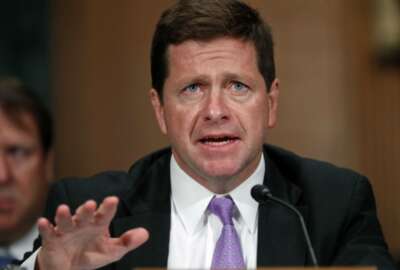

FEMA's deputy CIO said the agency's response during the 2017 hurricane season could give it leverage in asking for more resources.
The Federal Emergency Management Agency (FEMA) is continuing to help communities recover from the 2017 hurricane season, but Deputy CIO Patsy Garnett said the agency is also taking stock of what worked, what didn’t and what it can ask for in terms of future resources.
“We had just moved from the old [call center] system when Harvey hit, and we found that we weren’t able to handle these quantities,” Garnett said during a recent AFFIRM IT modernization event in Washington, D.C. “They were ready for about 3,000 [calls] to be able to be supported by this new system. Even though we thought that we were modernized and we had moved forward, we had moved a little bit. We’d improved that technology a bit, but we still found that we had significant issues when it came to the size that we were prepared to work in.”
Garnett said FEMA’s data replication solutions and its data warehouse were being overloaded by information being faxed in after the storm.
“We could have used that modernization earlier to provide the bandwidth that it needed,” Garnett said. “We were getting it 80 percent full on a daily basis, and having to work in the background. That’s where all the information was coming, through those two avenues. Modernization, we hadn’t quite gotten there yet. We were just starting in those areas.
Garnett said FEMA is working now to expand those systems, as well as modernizing its grants, flood insurance, and financial systems.
“We’re continuing right now to re-architect those areas using the newer technologies, we’re moving toward a DevOps type environment to be able to solve those challenges,” Garnett said. “It certainly allows us to have a different conversation when we are talking about the transformation. FEMA’s had a modernization plan that it’s been working on for a couple of years. It wasn’t that we didn’t have the plan, we just didn’t have the funding … because whenever there’s a disaster, there’s a lot of money that goes toward the disaster, but folks forget that the systems that you currently have in place are now going to be overloaded. We’ve been overloaded with four disasters, and that information is taxing our storage, it’s taxing the systems themselves. So it allows us to have a different conversation within DHS and with [the Office of Management and Budget] on what the needs are.”
FEMA’s efforts to modernize its IT systems are neither new, nor unique, and its fellow agencies are also working to balance IT wishlists and funding, amid differing definitions of successful modernization.
Secret Service Deputy CIO Ron Layton said for him modernization means staying current and knowing your threat landscape.
“It’s currency with what is going on in this particular environment,” said Layton, who was also a part of the IT modernization panel.
“The ultimate goal of modernization is making sure we can continue to modernize and continue to change,” said David Larrimore, chief technology officer for ICE. “We have had this kind of roadblock in a lot of agencies and a lot of organizations where that becomes an impossibility without throwing a lot of taxpayer money and time and dollars into it. That holds up the mission, and we literally have to slow down an entire organization to be able to get ourselves out of a cybersecurity nightmare in a lot of cases.”
For Rory Schultz, client executive at the Agriculture Department, modernization means opportunity and culture change.
Regardless of who is in office, Schultz said, when something changes, it’s up to civil servants to quickly figure out what are their new roles and goals.
“Cultural change is part of modernization,” Schultz said. “It always is. It’s not just about the hardware. So many times we think about hardware, software, how we’re going to implement it. But it is also us as federal employees and our contractor partners, adapting to that cultural change as they’re given it by their fed cohorts, or their fed leaders, or these senior folks in the agency.”
When it comes to culture, agencies are having to navigate transformations both internally and with customers.
Layton said when he considers cultural change, he thinks of an evolving ratio between digital natives and digital immigrants.
“The folks that show up now are very different than the folks who showed up 15 years ago,” Layton said. “They show up technically capable, technically competent, without even really knowing it, because they grew up with the technology.”
Layton said it was important to have people who can translate to customers what an agency’s technical staff is trying to say, and “sometimes that’s something we are a little bit lacking in the federal government.”
Customers are also more IT savvy and expecting more from government services, the panelists said.
“Not all customers of ICE like being customers of ICE,” Larrimore said. “That certainly makes things a little difficult and testy at times. Knowing that fact, knowing how sensitive it can be internationally; our customers are across the world, we are constantly hit from every angle. Every digital service we have is constantly being tested and scrutinized and that is really driving us to say we have to make change, we have to start delivering faster, because the problem is only going to get worse.”
Garnett said what she’s learned is if customers aren’t getting the services they want, they’ll find a workaround.
“The technology has become so available on the customer end, they have their fingers in it more and they want to tell how it’s supposed to be done,” Garnett said. “Our folks who are still using those older skills with the older technology don’t have as much patience and understanding.”
Customers shouldn’t necessarily have to come to the table with solutions for an agency, but an agency should be able to listen and understand what it is those customers are saying and what they want.
“We’ve become weak in both ends, we’re not able to really speak their language, in some cases they can speak it better than our technology staff can, and then we’re not able to really relate to what it is that they’re trying to achieve, which for an IT organization is deadly,” Garnett said. “We are reliant on that relationship with the customer, and if they don’t feel that we’re really there to help them get done what they need to have done, they will go around us. And it just makes the job so much harder.”
Copyright © 2025 Federal News Network. All rights reserved. This website is not intended for users located within the European Economic Area.



